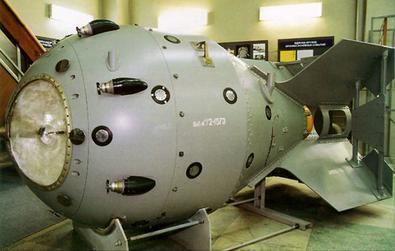Blast yield 22 kt (92 TJ) | ||
 | ||
The RDS-1 (Russian: РДС-1), also known as Izdeliye 501 (device 501) and First Lightning (Первая молния, Pervaya molniya), was used in the Soviet Union's first nuclear weapon test. The United States assigned it the code-name Joe-1, in reference to Joseph Stalin. It was detonated on 29 August 1949 at 7:00 AM, at Semipalatinsk, Kazakh SSR, after top-secret research and development as part of the Soviet atomic bomb project.
Contents
Description
The weapon was designed at the Kurchatov Institute—at the time officially known as "Laboratory № 2," but designated as the "office" or "base" in internal documents—starting in April 1946. Plutonium for the bomb was produced at the industrial complex Chelyabinsk-40.
The RDS-1 explosion yielded 22 kilotons of TNT, similar to the American Gadget and Fat Man bombs. At Lavrenty Beria's insistence, the RDS-1 bomb was designed as an implosion weapon similar to the Fat Man bomb dropped on Nagasaki, Japan; RDS-1 also had a solid plutonium core. The bomb designers had developed a more sophisticated design (tested later as RDS-2), but rejected it due to the known reliability of the Fat Man type design, the USSR having received extensive intelligence on the design of the Fat Man bomb during World War II.
In order to test the effects of the new weapon, workers constructed houses made of wood and bricks, along with a bridge, and a simulated metro in the vicinity of the test site. Armoured hardware and approximately 50 aircraft were also brought to the testing grounds, as well as over 1,500 animals to test the bomb's effects on life. The resulting data showed the RDS explosion to be 50% more destructive than originally estimated by its engineers.
There are several explanations for the USSR code-name of RDS-1, usually an arbitrary designation: a backronym "Special Jet Engine" (Реактивный двигатель специальный, Reaktivnyi Dvigatel Spetsialnyi), or "Stalin's Jet Engine" (Реактивный двигатель Сталина, Reaktivnyi Dvigatel Stalina), or "Russia does it herself" (Россия делает сама, Rossiya Delayet Sama). Later weapons were also designated RDS, but with different model numbers.
Mikhail Pervukhin served as the chairman of the commission in charge of the RDS-1 testing.
Response in the West
The test surprised the Western powers. American intelligence had estimated that the Soviets would not produce an atomic weapon until 1953, while the British did not expect it until 1954. When the radioactive fission products from the test were detected by the US Air Force, the US began to follow the trail of the nuclear fallout debris. President Harry Truman notified the world of the situation on September 23, 1949: "We have evidence that within recent weeks an atomic explosion occurred in the U.S.S.R." Truman's statement likely in turn surprised the Soviets, who had hoped to keep the test a secret to avoid encouraging the Americans to increase their atomic programs, and did not know that the United States had built a test-detection system using the WB-29 Superfortress. The announcement was a turning point in the Cold War that had just begun. Once the Soviet Union was confirmed to be in possession of the atomic bomb, pressure mounted to develop the first hydrogen bomb.
